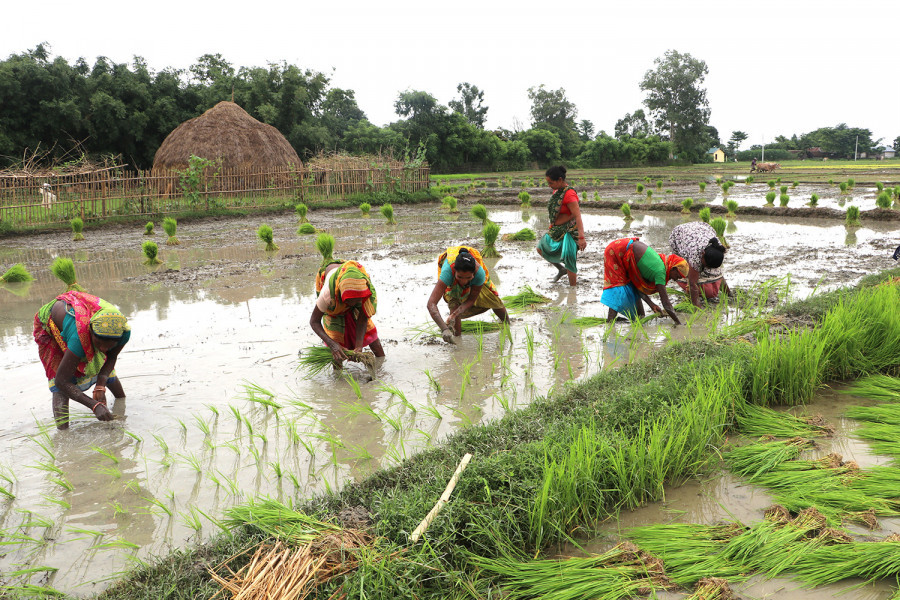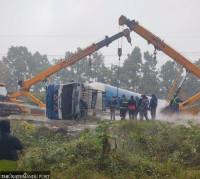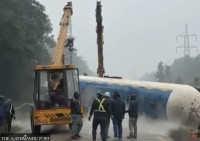National
Timely rains and plentiful labour promise a good paddy harvest
But experts say that a shortage of chemical fertilisers may play spoilsport.
Sangam Prasain & Bhusan Yadav
For Prabhu Yadav of Parsa, one good thing that came out of the Covid-19 pandemic has been that hordes of migrant workers have returned home. He was, therefore, not short of farmhands as in previous years. In addition, the timely and plentiful monsoon rains have raised his hopes of a good paddy harvest in November.
Yadav has already finished transplanting paddy on his two bigha (0.32 hectares) farm in Bahudarmai Municipality-9, one month before usual. He will soon return to his fields for the top dressing, done three weeks after transplantation, for which he needs urea. And that's where there might be a problem.
Urea is in short supply, raising doubts whether the farm sector and the economy will be able to cash in on the normal rainfall and abundance of farm labour.
“Covid-19 sent back thousands of workers who had left the village for work elsewhere to the fields. Good rainfall and adequate labour allowed us to finish transplantation within 15 days,” said Yadav.
Nationwide 92 percent of the paddy acreage of 1.37 million hectares has been completed as of Wednesday, according to the Department of Agriculture.
At this time last year, the transplantation had barely reached 64 percent, despite normal rainfall.
Eight districts of Province 2—Saptari, Siraha, Dhanusha, Mahottari, Sarlahi, Rautahat, Bara and Parsa—which together account for 365,615 hectares of paddy fields or 27 percent of the total paddy acreage in the country, are drought prone. But they have achieved the highest transplantation rate of 97 percent among the seven provinces, said the department.
“Paddy transplantation progressed at double the normal pace,” said Ram Chandra Yadav, chief of the Agriculture Knowledge Centre, formerly the District Agriculture Office, in Parsa.
Besides lack of rain there used to be shortage of farm workers too with the exodus of youths to foreign lands. As a result, Province 2 had been observing the lowest productivity rate for decades.
The monsoon is the lifeblood of Nepal's Rs3.76 trillion economy which is farm-dependent, as nearly two-thirds of the farmlands are rain-fed. Paddy contributes around 7 percent to the gross domestic product and is the key income source of farmers. Agriculture itself contributes 27 percent to the GDP.
The Tarai, which is the largest paddy producing region in the country, accounts for 71 percent of the total rice acreage. The hills account for 25 percent and the mountain region 4 percent. Nepali farmers gathered 5.55 million tonnes of paddy, the second largest harvest in history, in the fiscal year 2019-20.
Speaking at an interaction at the launch of the Nepal Development Update of the World Bank on Thursday, economist Shankar Sharma said that due to a good monsoon, paddy transplantation was going well, a good sign for the country’s economy. “But chemical fertiliser has not arrived on time, and that can be a problem,” he warned.
Experts have pointed out that timely application of chemical fertiliser on irrigated land can boost productivity by up to 20 percent.
This year, there was fertiliser shortage right from the start of the transplanting season that begins in early June. Diammonium phosphate (DAP), needed at the start while preparing seed beds and while transplanting, was in short supply and now it is the same with urea.
“We expect the supply of urea next week,” said senior agriculture economist Mahadev Prasad Paudel of the Department of Agriculture.
Bishnu Prasad Pokharel, spokesperson for Agriculture Inputs Company, the state-owned fertiliser supplier, said that they have ordered 50,000 tonnes of urea, and expect the shipment to arrive in the country after a month.
“Our planning failed due to the Covid-19 pandemic as all factories were shut down. The halt in transportation and border restrictions affected our plan to supply fertiliser on time,” he said.
He says there was no shortage of DAP now but it is not needed anymore.
Nepal requires 120,000 tonnes of urea and 50,000 tonnes of DAP for paddy transplantation which runs from early June to early-August.
“Salt Trading Corporation is bringing 25,000 tonnes of urea which could arrive soon. It will be enough for a month,” said Pokharel.
Kumar Rajbhandari, deputy general manager of Salt Trading Corporation, told the Post that the consignment of 25,000 tonnes of urea would arrive at Kolkata Port in India by the end of this month. “Then it will take at least a week to arrive in the country,” he added.
In the 2019-20 fiscal year, the government had increased the budget allocation for the distribution of subsidised chemical fertiliser from Rs5 billion to Rs9 billion to ensure timely supply and sufficient quantities, but the Covid-19 pandemic and lockdown affected supply chains.
Most of the fertiliser used in the country does not come through formal channels. According to the Agriculture Ministry, the annual demand for chemical fertiliser currently stands at more than 700,000 tonnes while imports amount to just around 300,000 tonnes. Subsidised fertiliser covers 40 percent of the country’s total need while the rest is met by informal imports or shipments smuggled across the open border.
This year, the problem was compounded when the entire southern border was sealed, and people were unable to sneak in any shipments, according to farmers.
The shortage of fertiliser has a multiplier effect since reduced production may prompt import bills soaring to meet domestic demand.
Nepal’s agricultural goods import bill ballooned to an all-time high of Rs220 billion previous fiscal year.
The cereal import bill alone amounted to Rs51.80 billion previous fiscal year, ending mid-July, with rice and paddy alone constituting more than Rs31 billion.
“I didn’t have to put my eyes to the skies and look anxiously for rain this year,” said Yadav. “Nor did I have to travel to villages in search of farmhand.”
But hundreds of thousands of farmers like him are now waiting for the timely availability of fertiliser.




 13.12°C Kathmandu
13.12°C Kathmandu














%20(1).jpg&w=300&height=200)

